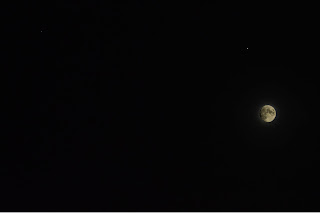August 30th 2145 GMT Moon
There was a hole in the cloud around the Moon, with it being close to full phase. I shot it with my DSLR at 300mm focal length, ISO 100 and 1/400 second exposure.
August 27th 0510 GMT Venus
Venus was high in the east before sunrise. I snapped it with
the same settings that I used for the Moon the evening before. Most of the frames were poor but I had one that was so spot-on that it could have been taken using a telescope.
August 26th 1940 GMT Moon
There was some thin cloud about but I managed a few frames
of the Moon at 300mm focal length, ISO 100 and 1/250 second exposure.
August 22nd 1930 GMT Moon
Sometimes, it is not so much a case of carefully planning a shot but grabbing an opportunity on an otherwise blank day. I caught the Moon through a gap in the cloud. I used my DSLR at 300mm focal length, ISO 100 and 1/125 second exposure.
August 20th 2145 GMT Meteor Hunt
Conditions were still poor but I aimed my camera in the area
of Cassiopeia in the hope of catching some Perseid meteors. I caught none on camera and had a look for a few minutes at a time but without success. Cloud and poor focus meant that none of the frames were any use for constellation shots.
August 20th 2055 GMT Jupiter and Saturn
Conditions were quite poor but I managed to catch three of Jupiter's moons.
I caught Jupiter with Saturn but the photo was not as good as the one earlier in the month.
August 18th 2135 GMT Perseid Meteor
This was probably one of the latest days in the year that I saw my first Perseid shower meteor, although I photographed a faint one a few days earlier. Conditions were poor but not completely impossible. There was thick moving cloud but the odd clear patch of about four degrees square at the most. I saw part of a trail of what seemed like a bright meteor. Within five minutes, the cloud gaps disappeared and that was that.
I decided against leaving a camera outside, due to the wet weather.
August 11th 0530 GMT Moon
I snapped the last quarter Moon with my DSLR at 300mm focal
length, ISO 400 and 1/250 second exposure.
August 9th 2310 GMT
I had been hoping to catch some Perseid meteors but the sky
was becoming lighter, due to the presence of the waning gibbous moon, which was
rather bright. I abandoned the meteor hunt and took some snaps of the Moon at
300mm focal length, ISO 100 and 1/500 second exposure.
I then snapped the Moon with Mars at 300mm focal length, ISO
6400 and 1/40 second exposure.
August 8th 2145 GMT Meteors
I set a camera to take automatic repeated shots of the area
of Cassiopeia at 18mm focal length, ISO 6400 GMT and 6 seconds exposure. The
intended target was the Perseid meteor shower.
I caught a sporadic meteor on camera at 2204 GMT.
I caught a much fainter sporadic meteor at 2217 GMT.
Finally, I stacked 25 early images to obtain a half-decent image of Cassiopeia and Cepheus.
August 8th 2130 GMT Jupiter and Saturn
I snapped Jupiter with its moons with my DSLR at 300mm focal
length ISO 6400 and 2 seconds exposure.
I
followed up with Jupiter with Saturn at 200mm focal length, ISO 6400 and 3
seconds exposure.
August 8th 0915 GMT Sunspot
I did a sunspot drawing from binocular observations.
I snapped the Sun with my DSLR at 300mm focal length, ISO 100 and 1/4000 second exposure. Unfortunately, the focus was not spot on, so I did not capture the sunspot.
I then did some afocal shots with my PST and DSLR in an attempt to capture hydrogen alpha features.
August 7th 0530 GMT Moon
The waning gibbous moon was in the south west. I
photographed it with my DSLR at 300mm focal length, ISO 400 and 1/500 second
exposure.
August 6th 1830 GMT Sun
A sunspot appeared and I did a drawing based on binocular observations.
August 1st 2240 GMT Meteors
I set my camera to take multiple exposures centred on
Cassiopeia in an attempt to catch Perseid meteors. I used my usual settings of
18mm focal length, ISO 6400 and 6 seconds exposure. I did not have any luck with meteors but stacked a few images to get a passable Cassiopeia.
August 1st 2235 GMT Moon, Jupiter and Saturn
I tried to photograph Jupiter’s moons but used a shorter
exposure as the shot was affected by glare from the Moon.
I then snapped the Moon, Jupiter and Saturn together at
150mm focal length, ISO 6400 and 1/50 second exposure.
I combined this with my Moon shot.
August 1st 2035 GMT Moon and Jupiter
I snapped the Moon at 300mm focal length, ISO 100 and 1/400
second exposure.
As Jupiter was very close, I upped the ISO to 6400 to catch
them both together.























